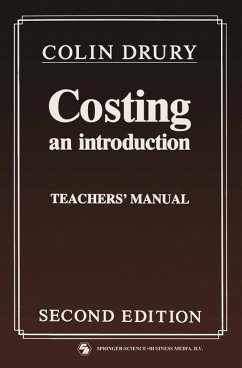
A Survey of Activity-Based Costing Practices Within the Department of the Army
Versandkostenfrei!
Versandfertig in über 4 Wochen
23,99 €
inkl. MwSt.
Weitere Ausgaben:

PAYBACK Punkte
12 °P sammeln!
Activity-Based Costing (ABC) does not appear to have been as readily accepted within the Department of the Army as within private industry (Kehoe et al., 1995). Barely able to accomplish their missions at current resource levels, military resource managers know historically that identified efficiencies and savings often are translated into self inflicted budget and manpower cuts. Yet, it is almost universally accepted that the benefits of using Activity-Based Costing are real and obtainable, but not yet worth the effort required with the perceived risk being taken. Current conventional wisdom ...
Activity-Based Costing (ABC) does not appear to have been as readily accepted within the Department of the Army as within private industry (Kehoe et al., 1995). Barely able to accomplish their missions at current resource levels, military resource managers know historically that identified efficiencies and savings often are translated into self inflicted budget and manpower cuts. Yet, it is almost universally accepted that the benefits of using Activity-Based Costing are real and obtainable, but not yet worth the effort required with the perceived risk being taken. Current conventional wisdom is for Army Resource Managers to wait and see what benefits and fates come to those who pioneer ABC. The US Army Cost and Economic Analysis Center (CEAC) had been charged with the role of establishing policy for ABC within the Army. Wanting to base policy on successful applications, their first task is to define Army ABC, and then to find such initiatives from which to draw from. The purpose of this thesis is to find Activity-Based Costing practices within the US Army, and then to use them to discover the major dimensions of ABC in the Army environment. This research found that the home of Activity-Based Costing is in the Army Major Commands and their subcommands. Within these commands there is much interest in ABC, but efforts are stymied by lack of policy and widespread knowledge of ABC principles. Training is perceived not as individual, but as an organizational need. Base Operations was identified as the area most suitable for ABC, while combat units the least. Overall, ABC is generally considered to be a positive tool which can be employed to help leadership better manage their operations and resources. This work has been selected by scholars as being culturally important, and is part of the knowledge base of civilization as we know it. This work was reproduced from the original artifact, and remains as true to the original work as possible. Therefore, you will see the original copyright references, library stamps (as most of these works have been housed in our most important libraries around the world), and other notations in the work. This work is in the public domain in the United States of America, and possibly other nations. Within the United States, you may freely copy and distribute this work, as no entity (individual or corporate) has a copyright on the body of the work. As a reproduction of a historical artifact, this work may contain missing or blurred pages, poor pictures, errant marks, etc. Scholars believe, and we concur, that this work is important enough to be preserved, reproduced, and made generally available to the public. We appreciate your support of the preservation process, and thank you for being an important part of keeping this knowledge alive and relevant.








![A new Income tax Manual [electronic Resource]: Explaining the Requirements of the Federal Income tax law and the Treasury Department Regulations With Cover A new Income tax Manual [electronic Resource]: Explaining the Requirements of the Federal Income tax law and the Treasury Department Regulations With](https://bilder.buecher.de/produkte/68/68813/68813208n.jpg)



